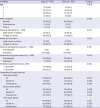1. Strasburger VC, Hogan MJ, Mulligan DA, Ameenuddin N, Christakis DA, Cross C, et al. Children, adolescents, and the media. Pediatrics. 2013; 132(5):958–961.
2. Kabali HK, Irigoyen MM, Nunez-Davis R, Budacki JG, Mohanty SH, Leister KP, et al. Exposure and use of mobile media devices by young children. Pediatrics. 2015; 136(6):1044–1050.

3. Cui Z, Hardy LL, Dibley MJ, Bauman A. Temporal trends and recent correlates in sedentary behaviours in Chinese children. Int J Behav Nutr Phys Act. 2011; 8(1):93.

4. Lee KS, Jung SJ, Kim MS. The influence of infants'(1–3 years) visual media overindulgence on their general, emotional and social development. Korean J Dev Psychol. 2015; 28(1):117–132.
5. Kılıç AO, Sari E, Yucel H, Oğuz MM, Polat E, Acoglu EA, et al. Exposure to and use of mobile devices in children aged 1–60 months. Eur J Pediatr. 2019; 178(2):221–227.
6. Baek HW, Shin YM, Shin KM. Emotional and behavioral problems related to smartphone overuse in elementary school children. J Korean Neuropsychiatr Assoc. 2014; 53(5):320–326.

7. Hogan MJ, Strasburger VC. Media and prosocial behavior in children and adolescents. In : Nucci L, Narvaez D, editors. Handbook of Moral and Character Education. Mahwah, NJ: Lawrence Erlbaum;2008. p. 537–553.
8. Brown A. Council on Communications and Media. Media use by children younger than 2 years. Pediatrics. 2011; 128(5):1040–1045.

9. Mistry KB, Minkovitz CS, Strobino DM, Borzekowski DL. Children's television exposure and behavioral and social outcomes at 5.5 years: does timing of exposure matter? Pediatrics. 2007; 120(4):762–769.

10. Rideout V. Parents, Media and Public Policy: a Kaiser Family Foundation Survey. Menlo Park, CA: The Henry J. Kaiser Family Foundation;2004.
11. Holloway D, Green L, Livingstone S. Zero to Eight: Young Children and Their Internet Use. London: EU Kids Online;2013.
12. Nelson MC, Neumark-Stzainer D, Hannan PJ, Sirard JR, Story M. Longitudinal and secular trends in physical activity and sedentary behavior during adolescence. Pediatrics. 2006; 118(6):e1627–e1634.

13. Bucksch J, Inchley J, Hamrik Z, Finne E, Kolip P. HBSC Study Group Germany. Trends in television time, non-gaming PC use and moderate-to-vigorous physical activity among German adolescents 2002–2010. BMC Public Health. 2014; 14(1):351.

14. Pate RR, Mitchell JA, Byun W, Dowda M. Sedentary behaviour in youth. Br J Sports Med. 2011; 45(11):906–913.

15. Duch H, Fisher EM, Ensari I, Harrington A. Screen time use in children under 3 years old: a systematic review of correlates. Int J Behav Nutr Phys Act. 2013; 10(1):102.
16. Byeon H, Hong S. Relationship between television viewing and language delay in toddlers: evidence from a Korea national cross-sectional survey. PLoS One. 2015; 10(3):e0120663.

17. Sigmundová D, Sigmund E, Badura P, Vokáčová J, Trhlíková L, Bucksch J. Weekday-weekend patterns of physical activity and screen time in parents and their pre-schoolers. BMC Public Health. 2016; 16(1):898.

18. Common Sense Media. Zero to Eight: Children's Media Use in America 2013. San Francisco, CA: Common Sense Media;2013.
19. Chang HY, Park EJ, Yoo HJ, Lee JW, Shin Y. Electronic media exposure and use among toddlers. Psychiatry Investig. 2018; 15(6):568–573.

20. Paudel S, Jancey J, Subedi N, Leavy J. Correlates of mobile screen media use among children aged 0–8: a systematic review. BMJ Open. 2017; 7(10):e014585.

21. Dennison BA, Erb TA, Jenkins PL. Television viewing and television in bedroom associated with overweight risk among low-income preschool children. Pediatrics. 2002; 109(6):1028–1035.

22. Park S, Chang HY, Park EJ, Yoo H, Jo W, Kim SJ, et al. Maternal depression and children's screen overuse. J Korean Med Sci. 2018; 33(34):e219.

23. Cristia A, Seidl A. Parental reports on touch screen use in early childhood. PLoS One. 2015; 10(6):e0128338.

24. Downing KL, Hinkley T, Salmon J, Hnatiuk JA, Hesketh KD. Do the correlates of screen time and sedentary time differ in preschool children? BMC Public Health. 2017; 17(1):285.

25. Berglind D, Tynelius P. Objectively measured physical activity patterns, sedentary time and parent-reported screen-time across the day in four-year-old Swedish children. BMC Public Health. 2017; 18(1):69.

26. Jago R, Thompson JL, Sebire SJ, Wood L, Pool L, Zahra J, et al. Cross-sectional associations between the screen-time of parents and young children: differences by parent and child gender and day of the week. Int J Behav Nutr Phys Act. 2014; 11(1):54.

27. Domingues-Montanari S. Clinical and psychological effects of excessive screen time on children. J Paediatr Child Health. 2017; 53(4):333–338.










 PDF
PDF Citation
Citation Print
Print




 XML Download
XML Download